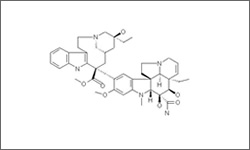Vindesine

Vindesine is a "semi-synthetic derivative of vinblastine," a related microtubule inhibitor. It is administered intravenously, and is metabolized by the liver prior to excretion in the urine. Cancers for which vindesine is used include acute lymphocytic leukemia, lung carcinomas, breast cancer, chronic myelogenous leukemia, colorectal cancer. 1
- 1Vindesine. 2014. http://www.nhs.uk/ipgmedia/national/Macmillan%20Cancer%20Support/Assets/VindesineMCS5pages.pdf
Vindesine (Eldisine®, Fildesin®), like other vinca alkaloids, binds to the tubulin building blocks used to make microtubules. Without these microtubules, dividing cells can not separate the newly replicated chromosomes, halting cell division. Aborted cell division leads to the induction of apoptosis or cellular suicide. 1
- 1Vindesine. 2014. http://www.nhs.uk/ipgmedia/national/Macmillan%20Cancer%20Support/Assets/VindesineMCS5pages.pdf
Common side effects include hair loss, rash, nausea and vomiting, constipation, stomach cramps, jaw pain, vein inflammation (phlebitis), decreased blood cell counts (also called bone marrow suppression or, myelosuppression), decrease in blood platelet number (thrombocytopenia).1
- 1Vindesine. 2014. http://www.nhs.uk/ipgmedia/national/Macmillan%20Cancer%20Support/Assets/VindesineMCS5pages.pdf
